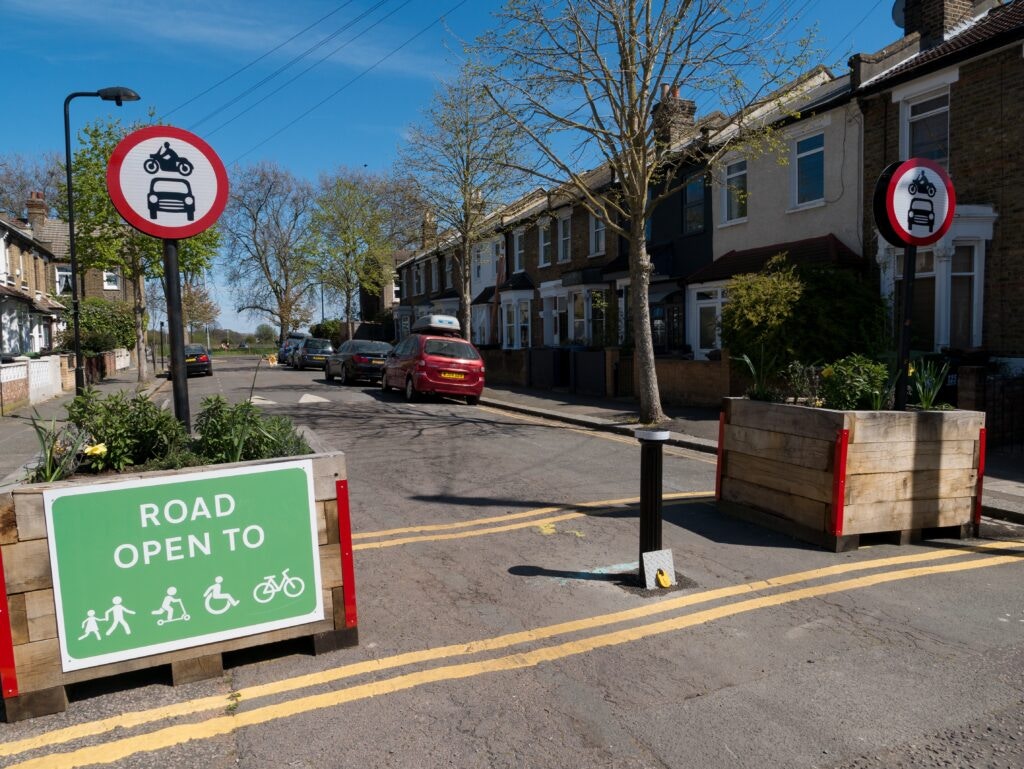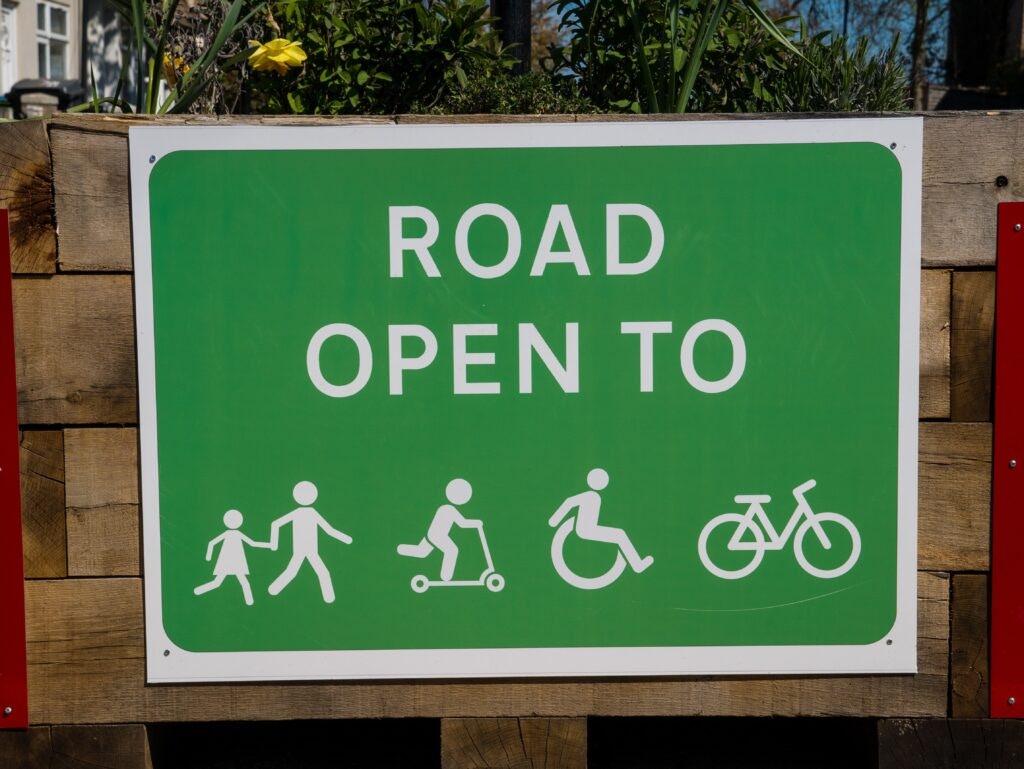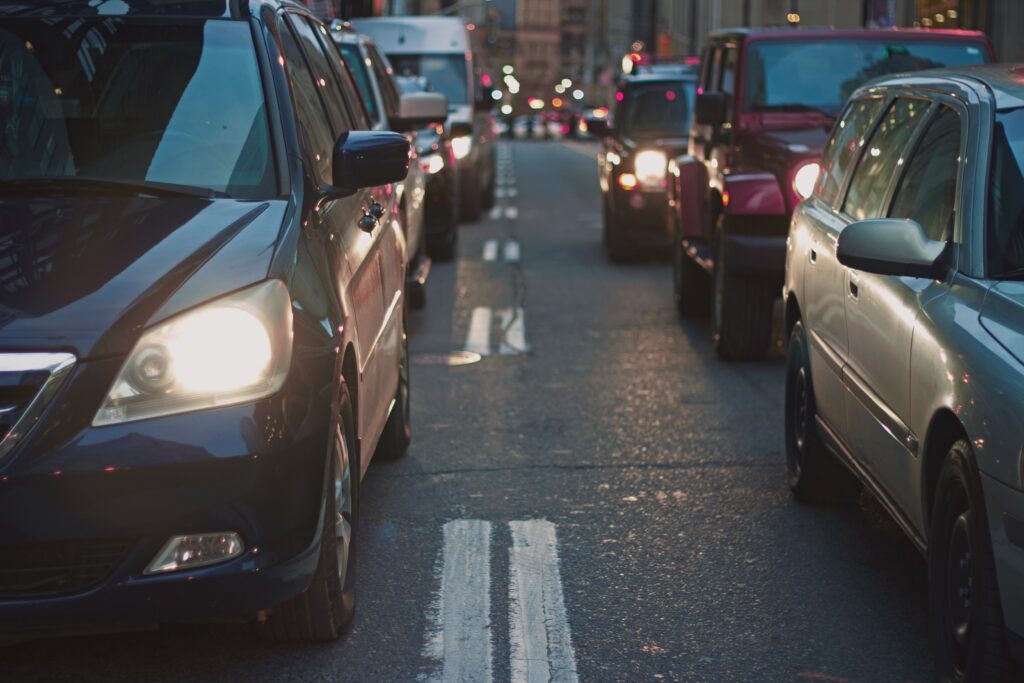What are London’s Low Traffic Neighbourhoods (LTNs)?

Low Traffic Neighbourhoods (LTNs) are innovative urban planning initiatives aimed at reducing traffic volume and creating safer, more sustainable, living environments.
Accordingly, these neighbourhoods have gained popularity as part of the city’s commitment to combat congestion, improve air quality, and promote active transportation.
- How do Low Traffic Neighbourhoods work?
- Why were Low Traffic Neighbourhoods introduced?
- What are the advantages of Low Traffic Neighbourhoods?
- Are there any disadvantages to LTNs?
- Will Transport for London continue introducing LTNs?
- Where are London’s LTNs located?
- Are there fines for driving in LTNs?
How do Low Traffic Neighbourhoods work?
LTNs, also known as ‘Healthy Streets’ or ‘Liveable Neighbourhoods’, are residential areas where traffic flow is restricted through the implementation of road closures, one-way systems, and traffic-calming measures. These changes aim to create environments that encourage walking, cycling, and public transport usage, whilst discouraging unnecessary car journeys.
LTNs were brought in to prevent residential areas, particularly where families with children reside, from being used as shortcuts for through traffic. This is achieved by implementing road closures, usually either using bollards or installing flower beds.
However, LTNs maintain accessibility for bicycles and pedestrians. For residents in the LTN areas, car access is still permitted.
Why were Low Traffic Neighbourhoods introduced?
LTNs were introduced as an urban planning strategy to address various issues relating to road safety and the overall health of London residents.
The main reasons for implementing LTNs are:
- Safer streets: LTNs are designed to enhance pedestrian safety by reducing the risk of accidents involving vehicles and promoting child-friendly environments
- Tackling congestion: By reducing car traffic within residential areas, LTNs help alleviate congestion in main roads, leading to smoother traffic flow citywide
- Promoting physical activity: Encouraging walking and cycling not only improves individual health but also reduces greenhouse gas emissions, contributing to a cleaner and greener city
- Enhancing air quality: Reducing motorised traffic in LTNs leads to decreased air pollution, benefiting both residents and the environment

What are the advantages of Low Traffic Neighbourhoods?
LTNs are promoted by Transport for London (TfL) as a way of making London streets better at handling the current large volume of cars. Due to the age of London, few streets were specifically designed to withstand the traffic flow of the modern city.
Research by TfL data shows that over 80% of deaths on London’s streets involve pedestrians, cyclists, or motorbike users. Therefore, by limiting car access to heavily-populated residential areas, collision risks are reduced – making streets safer for road users.
LTNs also encourage more people to walk and cycle, promoting a healthier lifestyle and reducing reliance on cars for short journeys. With fewer cars and vans on the road, LTNs also contribute to improved air quality in residential areas, benefiting both residents’ health and the environment.
Researchers from the Centre for London reviewed LTN impact studies, technical delivery guides, surveys on public opinions, and roundtables with professionals involved in LTN implementation. The report concluded that LTNs are effective and popular in London boroughs.
Are there any disadvantages to Low Traffic Neighbourhoods?
Critics of the LTN scheme argue that they hinder emergency services’ access to certain areas, which can delay response times during emergencies.
Also, as LTNs divert traffic to just London’s main roads, they can lead to increased traffic flow on main roads surrounding restricted areas, potentially causing greater congestion and longer travel times for commuters.
LTNs are also known to create challenges for delivery drivers and commercial vehicles, as they often cause delays and make finding delivery routes problematic.

Will Transport for London continue introducing LTNs?
Yes. In fact, TfL has already stated that it will be introducing further LTNs to London boroughs.
Whilst TfL has acknowledged temporary traffic increases in LTN areas – it has suggested this is not likely to be permanent. Traffic levels are being monitored in these areas – as well as bus journey times in and around LTNs. TfL has admitted that, in some places, traffic light timings may need to be adjusted, or further signage may be required to alleviate traffic congestion.
TfL is also collaborating with London’s emergency services to ensure that any changes to routes are promptly addressed.
Where are London’s LTNs located?
LTNs have already been introduced in several London boroughs. There are currently larger ones in Camden, Croydon, Ealing, Hackney, Hounslow, Islington, Lambeth, Newham, and Waltham Forest. Though, most London boroughs have now introduced LTNs.
Hackney is at the forefront of LTN implementation. The borough has ambitious plans to expand LTN coverage – should this go ahead as planned, 75% of the roads in the borough will be subject to LTN regulation by 2025.
Other boroughs, including Waltham Forest and Lambeth, that have enjoyed a positive response to this kind of urban planning, are also considering radical LTN implementation within the next decade.
Are there fines for driving in LTNs?
Yes. Last year, London drivers received 7.5 million penalty tickets, with the introduction of new LTNs. Data from TfL revealed a 41% increase, equating to 2.2 million more fines compared to the same period in 2020.
Motorists caught driving through LTNs without valid council-issued exemptions will receive a Penalty Charge Notice (PCN). The fine for this is currently £130 – though it can be reduced to £65 if paid within 14 days from the date of issue.
Haringey Council reportedly issued around 60,000 penalty charge notices to drivers who entered its three LTNs between September and December 2022. This led to revenue of nearly £2 million in just four months.
Selling your car?
Read up on everything you need to know about how to sell your car with more guides here. There’s a lot to learn as Clean Air Zones and emissions standards in the UK change in the run-up to 2035.
- Driving a van in London’s ULEZ – the 2023 guide
- Car CO2 emissions guide
- London congestion zone – the ultimate guide
- Birmingham congestion charge zone – the ultimate guide
- ULEZ exempt cars
- Diesel emissions claims – the ultimate guide (2022)
- The cities leading the EV charge
- Should you sell your diesel car?
- Should I sell my petrol car?
- Should I sell my hybrid car?
- Electric cars — the ultimate guide
- Electric cars — should you buy or sell?
- Selling your car and the 2035 electric car switchover
- Do electric cars pay the congestion charge?
- Electric car grants: the ultimate guide